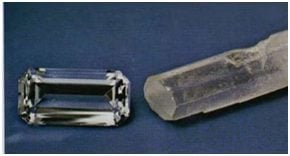Natrolite, Mesolite, Scolecite Value, Price, and Jewelry Information
All three minerals are fibrous or elongated zeolite minerals. Faceted gems are almost always elongated emerald cuts or step-cuts.
2 Minute Read
Start an IGS Membership today
for full access to our price guide (updated monthly).Natrolite, Mesolite, Scolecite Value
Solid-solution series, Zeolite Group.
Natrolite | Mesolite | Scolecite | |
| Crystallography | Orthorhobic, pseudo-tetragonal | Monoclinic, pseudo-orthorhombic | Monoclinic, pseudo-orthorhombic |
| Hardness | 5 | 5 | 5 |
| Specific Gravity | 2.2-2.26 | 2.26 | 2.21-2.29 |
| Optics: | |||
| a | 1.473-1.483 | 1.505 | 1.507-1.513 |
| β | 1.476-1.486 | 1.504-1.508 | 1.516-1.520 |
| γ | 1.485-1.495 | 1.506 | 1.517-1.523 |
| Sign | (+) | (+) | (-) |
| 2V | 58-64° | ~80° | 36-56° |
| Birefringence | 0.012 | 0.001 | 0.007 |
All three minerals are fibrous or elongated zeolite minerals that occur in single crystals or radial aggregates. Mesolite crystals are always twinned.
Colors: Colorless, white (natrolite sometimes gray, yellowish, reddish).
Luster: Vitreous; silky in fibrous varieties.
Fracture: Uneven. Brittle.
Cleavage: Perfect 2 directions.
Luminescence: Some natrolite fluoresces yellow-orange in LW (Germany). Indian mesolite may fluoresce pink (LW); mesolite may fluoresce cream white to green in LW (Colorado). None observed in scolecite. Occurrence: Cavities in basalts and other dark igneous rocks. Scolecite occasionally forms in schists and contact zones at limestones.
Colorado; New Jersey; Oregon: Washington.
Nova Scotia, Canada; Greenland; Scotland; Iceland;
Ice River, British Columbia, Canada.
California: natrolite in San Benito County; scolecite at Crestmore, Riverside County.
Poona, India: large crystals of scolecite and natrolite, some facetable.
Brevig, Norway: natrolite.
USSR: huge natrolite crystals.
Australia: mesolite.
Sicily: mesolite.
France: natrolite.
Germany: natrolite.
Rio Grande do Sul, Brazil: immense crystals of scolecite.
Brazilian scolecite reported: a = 1.512; β= 1.518; γ=1.523; birefringence = 0.011; S.G. = 2.21.
Mt. Ste. Hilaire, Quebec, Canada: large natrolite crystals (white, opaque).
Southern Quebec: in asbestos mines, natrolite crystals to 3 feet long and 4 inches across (not of gem quality).
Bound Brook, New Jersey: one find of natrolite crystals, thousands of single crystals well terminated, up to 6 inches long, many transparent.
Stone Sizes: Natrolites were known only in stones under 1 carat until the Bound Brook, New Jersey, find. Some of these crystals cut flawless gems over 20 carats.
Smithsonian Institution (Washington, D.C): 9.31, 7.9 (colorless, New Jersey).
Devonian Group (Calgary, Alberta, Canada): 7.95 (colorless, New Jersey); also scolecite, 0.98
(India).
Private Collection: 15 (lee River, British Columbia).
Mesolite is never found in large transparent crystals. Faceted gems are thus very rare, although the possibility exists that larger crystals could be found one day. Fibrous material cuts fine catseye gems, but these also are small and fragile.
Scolecite is also rare in facetable crystals; areas of some of the large Indian and Brazilian material might cut gems in the 5-10 carat range, but these specimens are in museums and will not be cut. Other stones would likely be in the 1-3 carat range and colorless.
Comments: All three zeolites form elongated crystals; faceted gems are almost always, therefore, elongated emerald- or step-cuts. The New Jersey natrolites are by far the largest known faceted gems in this group. All three minerals are relatively fragile and soft, have good cleavage, and are white and more or less uninteresting, except for rarity. Compact masses, cut into cabochons, might be more durable due to interlocking of the fibers. The minerals can readily be distinguished on the basis of optical properties.
Names:Natrolite from the Latin natron (soda) because of the presence of sodium. Mesolite from the Greek mesos, an intermediate position, because of its position between natrolite and scolecite in chemistry and properties. Scolecite is from the Greek skolex (worm) because a borax bead of the mineral sometimes curls up like a worm.
Joel E. Arem, Ph.D., FGA
Dr. Joel E. Arem has more than 60 years of experience in the world of gems and minerals. After obtaining his Ph.D. in Mineralogy from Harvard University, he has published numerous books that are still among the most widely used references and guidebooks on crystals, gems and minerals in the world.
Co-founder and President of numerous organizations, Dr. Arem has enjoyed a lifelong career in mineralogy and gemology. He has been a Smithsonian scientist and Curator, a consultant to many well-known companies and institutions, and a prolific author and speaker. Although his main activities have been as a gem cutter and dealer, his focus has always been education. joelarem.com
Related Articles
Black Diamond Value, Price, and Jewelry Information
Chameleon Diamond Value, Price, and Jewelry Information
Gray Diamond Value, Price, and Jewelry Information
Green Diamond Value, Price, and Jewelry Information
Latest Articles
800 Years of Mogok: A Celebration in Tenuous Times
What is the Average Gemstone Faceting Yield?
Pyroxmangite Value, Price, and Jewelry Information
How to Identify Emerald Simulants and Synthetics
Never Stop Learning
When you join the IGS community, you get trusted diamond & gemstone information when you need it.
Get Gemology Insights
Get started with the International Gem Society’s free guide to gemstone identification. Join our weekly newsletter & get a free copy of the Gem ID Checklist!
